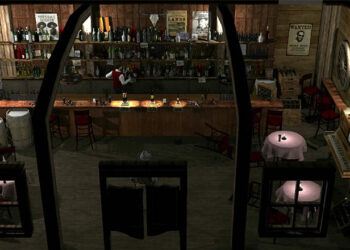Introduction
Training materials for Max have been available for years on various topics and in different formats, from HTML and video tutorials to books and VHS tapes. The huge amount of tutorials found on the Internet alone points to the widespread use of Max around the world and its extended userbase. In the past, however, it was difficult to find tutorials or educational material that could teach a proficient Max user advanced techniques (with a few valuable exceptions). Fortunately the landscape has been changing in the last few years: today there’s a growing offering of books and training DVDs aimed at the intermediate/advanced user.
The Advanced Visual Effects DVD by Allan McKay, contains over 14 hours worth of tutorials covering topics such as Particle Flow, Procedural Systems, Shaders, Afterburn, Reactor and MaxScript. McKay is an Australian freelance Technical Director who focuses primarily on visual effects for films and has worked for several high-profile companies including Blur Studios, Frantic Films, Discreet and Paramount Pictures. The DVD, published by TurboSquid, is aimed at Max users interested in visual effects and goes in-depth into what Particle Flow (P.F.) has to offer.
Inside “Advanced Visual Effects” DVD
The DVD is divided into six sections:

The volcano tutorial combines materials, displacements, Particle Flow and Afterburn
I. Particle Flow Basics – Section one gives a good introduction to P.F., explaining what makes it different from other Max particle systems and going through the functions of basic operators. It also shows how to create particle systems that function in a loop and how to emit particles based on textures.
II. Simple Particle Effects – This section deals with useful examples such as the creation of ocean whitecaps, making an object leave footprints or marks on the geometry of another object (real displacement) in a procedural way, and creating a laser beam that leaves a trace on the ground, among many others.
III. Using Procedurals – Shows how to create a terrain using materials maps and displacement, how to animate the erosion of a planet, and a useful way to dissolve one object into another using displacements and a cellular mask
IV. AfterBurn Effects – Gives some excellent examples on using Sitni Sati’s Afterburn plugin with particle systems to create realistic effects. These include the creation of different types of great-looking, volumetric explosions, slow moving banks of fog and the use of Afterburn’s capabilities in a real production case. This section assumes that the user has at least a basic knowledge of Afterburn and is clearly not intended as an introduction to the program.
V. Dynamics & Reactor – Covers many of Reactor’s features,including the use of Fracture. The tutorials of this section aren’t as advanced as those of previous sections, except fora very interesting one dedicated to particles and geometry,which uses scripting and P.F.
VI. Advanced Effects – As you would expect, this section provides some excellent tutorials with detailed explanation son how to create a volcano, the different elements that form a tornado, and a detailed explanation of an advanced version of McKay’s impressive drip system. This section also includes a tutorial that teaches how to use Maxscript to create a small UI that contains a few important parameters taken from a more complex P.F. tree in order to control a scene with a higher level of abstraction.
All the different examples shown in the DVD come with their corresponding Max scenes for users to edit and further experiment with. In addition, the DVD has more than 50 extra scenes that deal with Dynamics, Particles, Afterburn and Procedural Systems.
McKay speaks with a clear voice and he advances through the tutorials at a good pace. He usually starts the scene by creating the objects and particle events from scratch, on later tutorials he sometimes uses a pre-defined scene and particle event setup.

McKay explains step by step how to create this advanced drip system using Particle Flow
Now, as we all know, nothing is perfect under the sun, so let’s get to the criticisms. Some aspects of the DVD are not very polished: the video tutorials are seldom edited (so when McKay waits for the machine to render so do you), the audio is sometimes interfered with background noises which can be distracting, there are a couple of cases where the tutorial stops when you wouldn’t expect it, and the interface provided with the DVD for watching the tutorials is a bit awkward (no seek bar available) – so you’ll most likely end up watching the videos (readily accessible as AVIs)with another media player.
Something which I would’ve liked to see addressed in this DVD, since most Max users would find it useful sooner or later,is the use of Particle Flow for assembling and disassembling objects. There is currently no easy way of doing this with the standard operators provided by P.F. at the time of this writing and the best solution is to implement the effect via scripting. The missing piece in P.F. is hardly Mr. McKay’s responsibility, of course. (see Notes)
The above issues, however, do not detract significantly from the excellent content that this DVD provides.
Conclusions
The detailed examples contained in this DVD make it easy to understand the real power behind Max’s “new” particle system – non-linear workflow, particle events with custom attributes, re-usability, enhanced access to scripting,clean visual design and interface, etc. The truth is, after watching the DVD, complex setups in Particle Flow not only seem simple to understand, but one finds new and unusual ways to utilize particles in order to create procedural workflows for standard scenes. This is no doubt thanks to Mr. McKay’s expertise and the time he has spent polishing his problem-solving skills while working in production environments.
One of the few ways in which a proficient Max user could learn techniques of this quality for creating visual effects is attending master classes at SIGGRAPH. (see Notes) The content of such a class would probably amount to 10% of what can be found on this DVD. It does not take much calculation to realize that for experienced Max users who want to further enhance their skills in areas related to visual effects this DVD is an invaluable addition to their toolset. Still,a word of caution for those looking for that instant realistic tornado effect. This DVD puts its emphasis on teaching you the techniques for creating visually impressive effects, not on providing ready-made photorealistic scenes.
***
Related Links:
Allan McKay’s personal website
http://www.allanmckay.com
Turbo Squid, publishers of the DVD
http://www.turbosquid.com
Brandon Davis’s tutorials on Particle Flow
http://www.particlefx.com/education/PFlow/
Borislav Petrov’s most excellent MaxScripts for ParticleFlow page
http://www.scriptspot.com/bobo/
Forum dedicated to CG particles, moderated by the creator of Particle Flow
http://www.orbaz.com/forum
Forum dedicated to Particles and FX at the CG Academy
http://www.cg-academy.net/phpBB2/viewforum.php?f=3
CG Academy – Training DVDs related to Max and Visual FX
http://www.cg-academy.net
Notes:
– Oleg Bayborodin, the creator of Particle Flow is currently developing a set of operators for P.F. that deal with the fragmentation, assembly and disassembly of objects. Considering what he has already done with Particle Flow, expectations are high. Since these functions would be very useful for a great percentage of Max users it would be excellent news if Discreet could include them in the base package.
– Discreet has recently started selling DVDs from the 3DS Max master classes presented during SIGGRAPH, so buying the DVDs for those unable to attend SIGGRAPH is now an option. This is certainly very good news.
– The DVD has been created at a resolution of 1024×768,therefore it will only function inside of a DVD Drive connected to your PC.
– The videos require the TSCC codec to run, which is included in the DVD.
– Max comes with some very good Particle Flow tutorials.To get the most out of this DVD it is advisable to do them first.
Words edited by Eviya Vitola.
A Spanish version of this article is available from El Portal del 3D y la Animación.
Document last modified: January 7, 2005.









